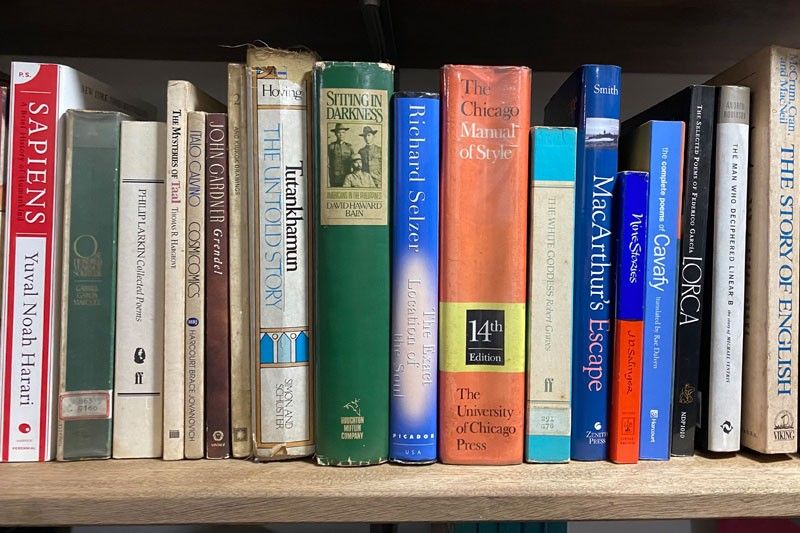My retirement library

I recently had occasion to reorganize my personal library, which involved trimming down hundreds of books into what could fit into a large aparador and three long shelves running along the wall of my study. Having retired for a year now, I thought that it was time to start bringing my worldly possessions down to the core, down to things I would actually live with in my old age, however short or long that grace period is going to be.
As you can imagine, this was easier said than done. Downsizing a library takes a lot more than a physical effort. It means going over a virtual history of your own mind, every book bought and kept being a marker of sorts of whatever it was you found interesting at that moment.
To force my hand and speed things up, last November I picked out and donated four large boxes of over 150 books to a benefit sale being held by students in my department in UP, mostly literature books and texts only an English major could love. As I was packing them up I remembered how, in my student days, we scoured the sales at Alemar’s and the old PECO as well as the used-book bins along Recto for bargains, clucking like well-fed chickens when we came across a prize catch (for me then, an orange-spined Penguin book by the likes of Graham Greene or John Updike).
Having a fixed space to move my books into also obliged me to choose well and wisely. In the end I decided that for simplicity’s sake my retirement library would contain only books that fell into certain categories: (one) books I myself wrote (around 40) and edited or contributed to (another 60 or so); (two) books signed by fellow authors; (three) books that were good or important to have, including antiquarian books, Filipiniana, Rizaliana, books on pens, machines, art and design, and collecting in general; and (four) most importantly, my personal favorites — the books that, for the past 50 years, I loved to read or would want to re-read, and, for some new ones, will want to read in retirement. It’s that last shelf I’ll dwell on for now.
As a fictionist, my favorite books of fiction are of course represented: William Kennedy’s Ironweed, J. D. Salinger’s Nine Stories, Italo Calvino’s Cosmicomics, John Gardner’s Grendel, Gabriel Garcia Marquez’s One Hundred Years of Solitude, and Hubert Selby’s Last Exit to Brooklyn, which Franz Arcellana told our class was the most disgusting book he had ever read, prompting me to rush out and look for it. (I still have to find my copy of D. M. Thomas’ The White Hotel.) Anthologies and books by my favorite poets include those by Robert Graves, Constantine Cavafy, Philip Larkin, and Federico Garcia Lorca.
There are also books about the practice and culture of writing: Simon Garfield’s Just My Type, Philip Hensher’s The Missing Ink: The Lost Art of Handwriting, Lynne Truss’ Eats, Shoots & Leaves, The Chicago Manual of Style, Strunk & White’s The Elements of Style, Thomas Larson’s The Memoir and the Memoirist, The Story of English by McCrum, Cran, and MacNeil, William Harris’ Ancient Literacy, and Alberto Manguel’s A History of Reading (a gift from F. Sionil Jose, who asked me to pick a book off his shelf).
If my Pinoy writer-friends don’t see their books among my favorites, that’s because they’re on the shelf of autographed books, alongside those signed by John Updike, Edward Jones, Junot Diaz, Romesh Gunesekera, Charles Baxter, Lawrence Durrell, Kazuo Ishiguro, and J. M. Coetzee, as well as, of course, the Filipino standouts: Jose Garcia Villa, Nick Joaquin, and even Carlos P. Romulo (who, let’s not forget, was one of five Filipinos to have won the Pulitzer Prize, mainly for journalism).
For fun, I keep books on poker (James McManus’ Cowboys Full and Positively Fifth Street) and books about Apple and Macs (Michael Malone’s Infinite Loop, Young and Simon’s iCon: Steve Jobs and the Greatest Second Act in the History of Business, Leander Kahney’s The Cult of Mac), as well as E. S. Lumsden’s The Art of Etching, which guided and inspired my shortlived career as a printmaker in the 1970s.
Perhaps most surprising is the predominance of history and nonfiction on this shelf, a tip of the hat to what I might have gone into as a profession if not for creative writing, although it’s mostly popular history for the enthusiast: Kenneth Clark’s Civilisation and James Burke’s Connections, Yuvel Noah Harari’s Sapiens, the Hakluyt edition of Morga’s Sucesos, Brian MacAllister Linn’s The Philippine War 1899-1902, Alan Moorehead’s Gallipoli, Dava Sobel’s Longitude, David Howard Bain’s Sitting in Darkness, Thatcher Freund’s Objects of Desire, Anna Pavord’s The Tulip, Nick Joaquin’s Manila My Manila (and his Reportage series), Richard Selzer’s Confessions of a Knife and Mortal Lessons, David Ogilvy’s Confessions of an Advertising Man, Ken Adler’s The Measure of All Things, and William Pomeroy’s The Forest (which I often cite as the most influential book of my young life, because it made rebellion sound romantic, and encouraged me to carry a placard).
When I step back and survey what I’ve chosen to put together (perhaps too unabashedly male), I can still see that boy who was fascinated not so much by fiction but by how things worked and by what the world out there was like (Sobel’s Longitude will tell you that). Because (no thanks to poor math skills) I couldn’t become an engineer and make clocks and centrifuges, literature and creative writing became my second choice — to see how words worked, like cogs in a fine machine.
* * *
Email me at jose@dalisay.ph and visit my blog at www.penmanila.ph.



















